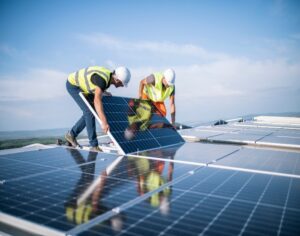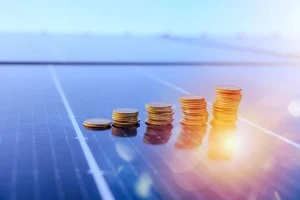
Maximising ROI While Transitioning to Clean Energy
With the rise in operational energy costs and a national push for carbon neutrality, commercial solar installations are no longer just a sustainability move — they are a strategic financial decision. Singapore’s solar energy capacity has grown more than six-fold over the past five years, driven primarily by private-sector adoption. Today, commercial entities contribute over 60% of the installed solar capacity islandwide.
As utility tariffs continue to rise by 4–6% annually on average, solar energy is fast becoming a hedge against volatility. Businesses that previously paid around 20 cents per kWh in 2019 now see rates reaching up to 28.7 cents per kWh in 2024, depending on their energy load profile and contract terms. These increases have widened the cost gap between grid electricity and solar, making the economics of solar more attractive.
Commercial Solar Financing & ROI Summary
| Category | Details / Data Points |
|---|---|
| Market Trend | – Solar capacity grew 6× in 5 years – Over 60% of solar capacity from commercial sector |
| Utility Tariffs | – Avg. annual increase: 4–6% – 2019: ~20¢/kWh → 2024: Up to 28.7¢/kWh |
| Solar LCOE | – 14–19¢/kWh (based on site factors) – Up to 30% savings for high-load businesses |
| Performance Ratio (PR) | – 80–90% yield efficiency (improved due to better tech) |
| Payback Period | – 4–6 years (Direct Purchase) – 7–9 years (Rent-to-Own) |
| IRR Range | – Direct Purchase: 12–16% – PPA: 8–10% – Rent-to-Own: 10–14% |
| Ownership Models | – Direct Purchase: Full CapEx upfront, max ROI, full control – PPA: Zero upfront, pay per kWh, no ownership – Rent-to-Own: Monthly instalments, ownership after 5–10 yrs – Green Loan: Bank-financed with 3–5% interest |
| Example System Cost | – 100 kWp system: S$130K–S$150K – Savings over 25 yrs: S$500K–S$650K |
| PPA Rate vs Grid | – PPA: 22–24¢/kWh – Grid: ~28¢/kWh – Savings: Up to S$30K/year (100 kWp system) |
| RTO Example | – Lease: S$2,800/month – Grid bill: S$3,240/month – Immediate savings: ~13.5% |
| Green Loan Example | – S$200K loan @ 4% for 7 years = ~S$2,700/month – System savings: S$3,000–S$3,500/month |
| O&M and Warranties | – O&M: 1–3 years included – Panel/inverter warranty: 10–12 years – Performance warranty: 25 years (80–85%) |
| Insurance & Compliance | – Covers: Electrical/fire damage, theft, business interruption – Compliant with SS 638 and Eurocode – PE-endorsed drawings often required |
| When to Choose Which Model | – CapEx: Long-term location, strong cash flow – PPA: No CapEx, tenant businesses – RTO: Preserve cash flow, eventual ownership – Green Loan: Ownership with spread cost, green financing eligible |
| Outlook to 2030 | – Target: 2 GWp by 2030 – Key growth from commercial sector – LCOE to drop by 10–15% next 5 years – Technologies: Floating solar, BIPV, battery storage |
| Main Benefit | Solar = Lower bills + Hedge against volatility + Sustainability compliance |
Understanding Solar’s Cost Advantage
Commercial rooftop solar systems in Singapore can achieve a Levelised Cost of Electricity (LCOE) between 14 to 19 cents per kWh, depending on roof type, system size, and energy load. For high-consumption businesses such as logistics hubs or manufacturing plants, this represents up to 30% savings compared to grid-supplied electricity.
Moreover, performance ratios of commercial systems have improved due to higher module efficiency and smarter inverters, with average yield efficiency ranging from 80% to 90%. With a payback period as short as 4 to 6 years for large-scale installations, commercial solar delivers a compelling internal rate of return (IRR) in the range of 10% to 16%, depending on the financing method used.
Overview of Commercial Solar Financing Models
Businesses in Singapore have access to several financing models that suit different capital structures and risk appetites. The most common approaches include:
1. Direct Purchase (CapEx Model)
Under this model, the company pays the full cost of the solar installation upfront and owns the system outright. This model offers the highest long-term returns since there are no lease payments or profit-sharing with third parties. In Singapore, this approach is particularly popular among companies with strong liquidity and a long-term investment horizon.
A typical 100 kWp rooftop system may cost around S$130,000 to S$150,000, depending on installation complexity. Over a 25-year system life, this could yield cumulative savings of S$500,000 to S$650,000, with a breakeven in less than six years for most commercial applications.
2. Power Purchase Agreement (PPA)
The PPA model is ideal for businesses seeking to reduce upfront costs and transfer system performance risk to a third party. A solar provider funds, installs, owns, and maintains the system, while the business agrees to purchase the generated solar electricity at a fixed rate per kWh for a duration of 15–25 years.
PPA rates are typically 10% to 25% lower than the prevailing utility tariff, offering immediate savings with zero capital expenditure. For example, if a company is paying 28 cents per kWh to SP Group, a solar PPA might offer a locked-in rate of 22 to 24 cents per kWh — translating into annual savings of up to S$30,000 for a 100 kWp system.
In addition to cash flow relief, the fixed-rate contract protects businesses against future utility price hikes, which have historically risen faster than inflation.
3. Solar Leasing / Rent-to-Own (RTO)
A hybrid between ownership and leasing, Rent-to-Own allows businesses to spread the cost of solar over 5 to 10 years via monthly instalments. At the end of the lease period, full system ownership is transferred to the business.
Monthly payments are often structured to match or be lower than current utility bills. For instance, a business consuming 12,000 kWh/month and paying 27 cents/kWh (S$3,240) could lease a solar system for S$2,800/month — saving 13.5% monthly from day one.
RTO models appeal to SMEs with moderate cash flow who want the long-term asset without the upfront burden. Many plans also include full O&M (operations and maintenance), and some providers offer early buyout options after the fifth year.
4. Green Loans and Bank Financing
Banks and financial institutions in Singapore now offer solar-specific loans as part of green financing initiatives. Interest rates range between 3% and 5% per annum, with repayment tenures from 5 to 10 years.
A S$200,000 commercial solar loan at 4% over 7 years would amount to monthly payments of roughly S$2,700, while the system could generate S$3,000–S$3,500 worth of savings monthly — making the project net-positive even during the financing period.
These loans are commonly used by businesses that want full ownership but need to preserve working capital. They also help improve ESG ratings, which are increasingly important for accessing institutional funding and corporate partnerships.
Key Financial Metrics to Evaluate

When comparing financing models, businesses should consider:
| Metric | Upfront Purchase | PPA | Rent-to-Own |
|---|---|---|---|
| CapEx Required | High | None | Low |
| Ownership Timeline | Immediate | Never | After Lease |
| IRR Range | 12%–16% | 8%–10% | 10%–14% |
| Payback Period | 4–6 years | Not applicable | 7–9 years |
| Monthly Savings | Highest | Moderate | Moderate to High |
| O&M Responsibility | Business | Solar Provider | Shared or Included |
Depending on the model chosen, businesses can expect savings of 20% to 30% on their total energy costs over the system lifetime.
Long-Term Returns and Risk Mitigation
When considering solar financing, it’s essential to evaluate not just the upfront numbers but also the system’s long-term financial and operational impact. Businesses that opt for direct ownership typically recover their investment within 4 to 6 years, after which the system delivers free electricity for the remainder of its 25–30 year lifespan.
Power Purchase Agreements, while offering modest savings during the contract period, often include buyout clauses at the 10th or 15th year, allowing businesses to take over the asset at a depreciated cost. Rent-to-own customers gain similar benefits after lease maturity, enjoying up to 15 additional years of electricity savings without further capital expenditure.
Maintenance, Performance Monitoring & Warranties
Most commercial solar providers include operations and maintenance (O&M) packages for the first 1–3 years, covering routine inspection, cleaning, and fault detection. After this period, service contracts can be extended or taken over in-house, depending on the client’s preferences.
Smart monitoring systems now offer real-time visibility into system performance, including inverter output, module temperature, and degradation alerts. This allows building managers to maintain systems within an 80–90% performance ratio (PR), which is considered optimal for Singapore’s climate.
System warranties typically include:
-
10 to 12 years product warranty on panels and inverters
-
25 years performance warranty (guaranteeing 80–85% efficiency at year 25)
Inverter replacement is often needed once during the system’s life, typically after 10–12 years, and accounts for around 8–10% of the total system cost.
Insurance and Compliance
Commercial solar systems can be insured under standard property or fire policies, with extensions for:
-
Electrical damage
-
Power surges
-
Theft or vandalism (especially for ground-mounted arrays or carports)
-
Business interruption
Risk mitigation should also include ensuring compliance with local structural codes, such as SS 638 (electrical installation) and Eurocode load calculations for rooftop mounts. Businesses should verify that the installer provides PE-endorsed drawings, which are often required for regulatory approval and to claim tax benefits.
Choosing the Right Financing Model
The ideal solar financing option depends on several operational and financial variables:
CapEx (Direct Purchase) is ideal when:
-
Your business has healthy cash reserves
-
You want to maximise ROI and tax benefits
-
You plan to stay in the same location long term
PPA is suited for:
-
Companies that want to avoid CapEx
-
Tenants with leasehold buildings (subject to landlord approval)
-
Firms prioritising risk-free energy savings
Rent-to-Own works well when:
-
Cash flow must be preserved
-
You want eventual ownership without upfront cost
-
Long-term asset value is important to your balance sheet
Green Loans are recommended if:
-
You prefer ownership but want to spread the cost
-
You qualify for preferential green financing rates
-
You can access government-backed loans (e.g., Enterprise Financing Scheme – Green)
Market Outlook: Solar’s Role in Singapore’s Energy Future
Singapore’s commercial solar uptake is set to accelerate as energy costs rise and sustainability mandates tighten. The nation aims to hit 2 GWp of installed solar capacity by 2030, with most of this growth expected to come from industrial, commercial, and institutional sectors.
Floating solar, BIPV (Building-Integrated PV), and battery storage solutions will complement traditional rooftop systems in the coming decade, offering new forms of value generation. In particular, battery-backed solar may unlock further independence from the grid, especially for critical operations such as cold storage, manufacturing, or server facilities.
As solar system prices continue to decline and installation efficiency improves, the LCOE for commercial solar is projected to fall another 10–15% over the next five years — making projects even more financially viable for SMEs and MNCs alike.
Final Thoughts: Turning Roofs Into Revenue
Switching to solar is not merely a green initiative — it is a strategic cost control mechanism. Businesses in Singapore can now choose from a variety of financing options that suit different risk profiles, ownership preferences, and capital constraints.
Whether your priority is reducing energy bills, meeting corporate sustainability goals, or improving long-term asset value, solar delivers across all fronts. The key is partnering with a solar provider that understands your business needs and offers a tailored financing model backed by performance guarantees, regulatory compliance, and ongoing support.
Ready to explore the best solar financing model for your commercial building?
First Solution Group offers site feasibility assessments, detailed ROI forecasts, and customised proposals for factories, schools, malls, and office buildings.
Contact us for a no-obligation consultation and turn your rooftop into a revenue-generating asset.